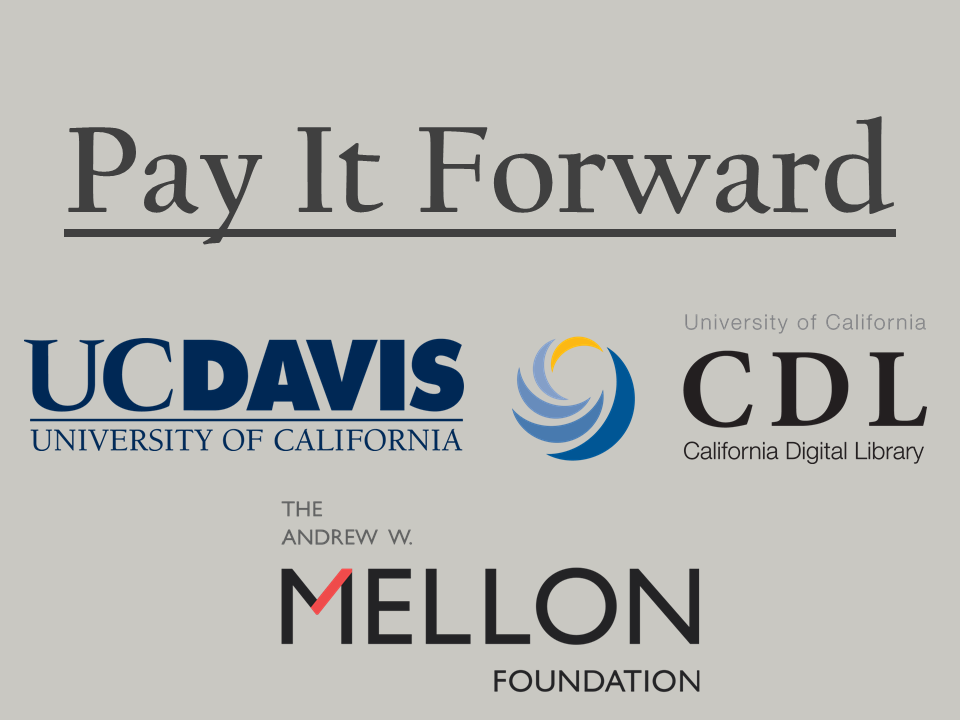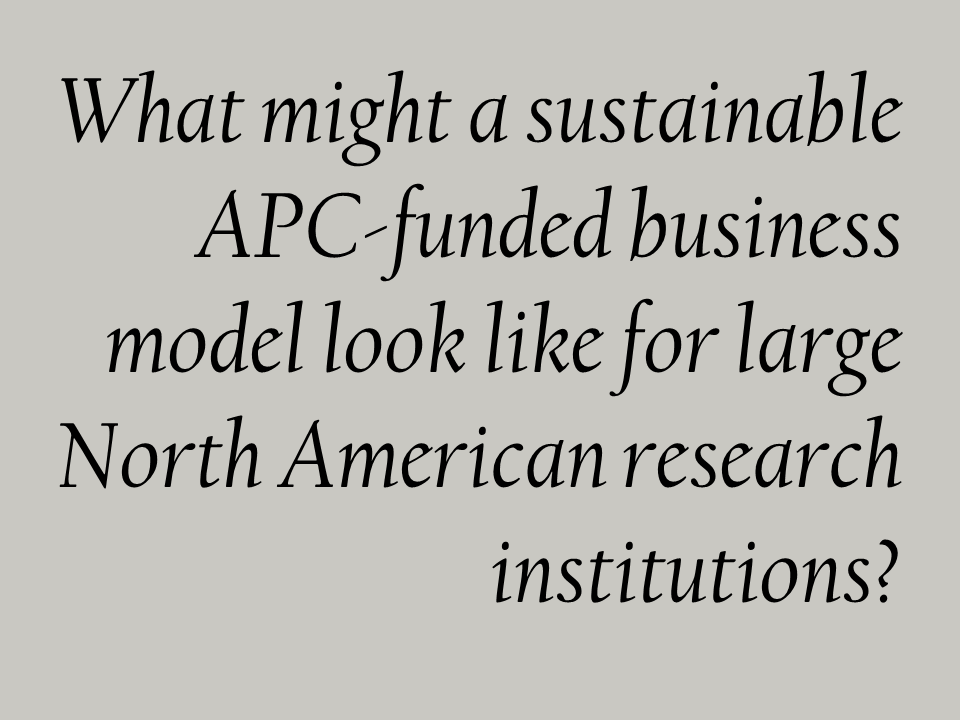The Pay It Forward project was conducted during 2015 and the first half of 2016 under the leadership of UC Davis and the California Digital Library. This post by Mathew Willmott and Ivy Anderson, two of the CDL principals on the project, discusses the driving forces behind this effort, the research goals pursued, and the major results produced from the work.

Open access to the journal literature is a long-cherished goal of many authors, academic institutions, and other stakeholders in the scholarly communication system; how to reach that goal in an economically sustainable way is a central question that continues to engage many in our community. In the U.S., open access policies at the institutional, state, and federal levels have focused on the ‘green road’ to open access, whereas developments in Europe have broadly embraced gold OA approaches along with green.
A move toward universal gold OA has recently begun to attract significant worldwide interest as a result of the Max Planck Society’s OA2020 Initiative and a similar call to action issued by the European Union last May. However, gold open access, particularly when funded via article processing charges, poses significant financial challenges for research-intensive institutions with high publishing activity. In Europe, research funder policies are addressing this gap, but comparable mechanisms have not taken hold in other parts of the world.
Is there an economically viable path to broad adoption of APC-based gold OA for those of us in North America?
The just-completed Pay It Forward project, an effort of the University of California, Davis and the California Digital Library with funding from the Andrew W. Mellon foundation, is an attempt to answer that very question. This ambitious 18-month project brought together research libraries at Harvard, Ohio State University, the University of British Columbia, and all ten University of California campuses; publishing industry and bibliometric partners from Thomson Reuters (Web of Science), Elsevier (Scopus), and the Association of Learned and Professional Society Publishers; and scholarly communications experts and researchers at several institutions across North America and Europe.
The research team addressed the viability and sustainability of a financial model for scholarly publishing funded entirely through article processing charges (APCs) from the perspective of large, research-intensive North American institutions. This evaluation involved both a qualitative assessment of authors’ attitudes towards open access publishing through APCs, undertaken through a series of focus groups and a large-scale author survey across several of the institutional partners on the project, and a quantitative financial evaluation, performed through an in-depth analysis of a wealth of data describing institutional publishing patterns, library subscription expenditures, extramural research funding, and publisher pricing patterns. By combining the results of these qualitative and quantitative processes, the team proposed hypothetical models for distributing costs among stakeholders in the scholarly publication process, with varying economic implications.
 The project draws several important conclusions which we hope will advance the discussion of an APC-funded model for scholarly publishing- and, more broadly, provide greater context for the exploration of a large-scale ‘flip’ of the journal literature to open access.
The project draws several important conclusions which we hope will advance the discussion of an APC-funded model for scholarly publishing- and, more broadly, provide greater context for the exploration of a large-scale ‘flip’ of the journal literature to open access.
- First, for research-intensive North American institutions, library journal budgets alone are unlikely to be sufficient to fund publishing activities through APCs. However, the difference in funding could be made up by other stakeholders, such as granting agencies, who in many cases already support publishing costs.
- Second, while author attitudes towards open access publishing vary across disciplines, all authors exhibit price sensitivity with regards to publishing charges. Leveraging this price sensitivity appropriately has the potential to induce competition in the marketplace, thereby restraining costs.
- And finally, funding models can be developed which ensure that authors have some “skin in the game” while still providing sufficient financial support to allow these authors the freedom to choose where to publish. One possibility is to provide a flat library subsidy that would approximately cover the costs of publishing in a baseline-level journal and then to establish author discretionary funds that are controlled by authors and can be used for publishing costs above the subsidy level, as well as for any other research activity. In this way, the institution provides funding to support its authors’ publishing activity along with other research activities, requiring authors to think strategically about where their discretionary funds would be best invested.
This is not to imply that there is no need for the library in an APC environment. In fact, respondents to the author survey demonstrated a preference for the library to play an active role. Authors trust libraries to manage the infrastructure and publisher relationships needed to transition to an OA model, as well as to attend to the long-term stewardship of the scholarly literature. Additionally, many authors would like the library to assist financially, either by coordinating and paying the APC or by negotiating fees directly with publishers.
Learn more about the Pay It Forward project and how its findings might relate to your institution through the following project deliverables:
- final report
- publicly-available datasets, compiled and used throughout the project
- Excel-based tool that enables other institutions to replicate the study within a local context by estimating an institution’s publication costs and funding distributions under various conditions
All are available at http://icis.ucdavis.edu/?page_id=713.
What’s next for this project? In addition to discussing the findings widely with a broad range of stakeholder communities, the project team is contemplating potential follow-on work to consider a variety of open questions, including the policies and infrastructure that might be needed to take these ideas from concept to reality.
We invite comments about this work and the larger questions it raises about how a large-scale conversion of the journal literature can be achieved. Let the commenting begin!
Tags: Articles, CDL, Mellon, Open Access, UC Davis



